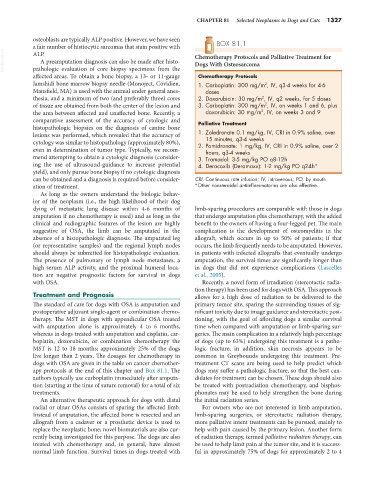Page 1355 - Small Animal Internal Medicine, 6th Edition
P. 1355
CHAPTER 81 Selected Neoplasms in Dogs and Cats 1327
osteoblasts are typically ALP positive. However, we have seen
a fair number of histiocytic sarcomas that stain positive with BOX 81.1
VetBooks.ir ALP. Chemotherapy Protocols and Palliative Treatment for
A preamputation diagnosis can also be made after histo-
Dogs With Osteosarcoma
pathologic evaluation of core biopsy specimens from the
affected areas. To obtain a bone biopsy, a 13- or 11-gauge Chemotherapy Protocols
Jamshidi bone marrow biopsy needle (Monoject, Covidien, 1. Carboplatin: 300 mg/m , IV, q3-4 weeks for 4-6
2
Mansfield, MA) is used with the animal under general anes- doses
thesia, and a minimum of two (and preferably three) cores 2. Doxorubicin: 30 mg/m , IV, q2 weeks, for 5 doses
2
2
of tissue are obtained from both the center of the lesion and 3. Carboplatin: 300 mg/m , IV, on weeks 1 and 6, plus
2
the area between affected and unaffected bone. Recently, a doxorubicin: 30 mg/m , IV, on weeks 3 and 9
comparative assessment of the accuracy of cytologic and Palliative Treatment
histopathologic biopsies on the diagnosis of canine bone
lesions was performed, which revealed that the accuracy of 1. Zoledronate 0.1 mg/kg, IV, CRI in 0.9% saline, over
15 minutes, q3-4 weeks
cytology was similar to histopathology (approximately 80%), 2. Pamidronate: 1 mg/kg, IV, CRI in 0.9% saline, over 2
even in determination of tumor type. Typically, we recom- hours, q3-4 weeks
mend attempting to obtain a cytologic diagnosis (consider- 3. Tramadol: 3-5 mg/kg PO q8-12h
ing the use of ultrasound-guidance to increase potential 4. Deracoxib (Deramaxx): 1-2 mg/kg PO q24h*
yield), and only pursue bone biopsy if no cytologic diagnosis
can be obtained and a diagnosis is required before consider- CRI, Continuous rate infusion; IV, intravenous; PO, by mouth.
ation of treatment. *Other nonsteroidal antiinflammatories are also effective.
As long as the owners understand the biologic behav-
ior of the neoplasm (i.e., the high likelihood of their dog
dying of metastatic lung disease within 4-6 months of limb-sparing procedures are comparable with those in dogs
amputation if no chemotherapy is used) and as long as the that undergo amputation plus chemotherapy, with the added
clinical and radiographic features of the lesion are highly benefit to the owners of having a four-legged pet. The main
suggestive of OSA, the limb can be amputated in the complication is the development of osteomyelitis in the
absence of a histopathologic diagnosis. The amputated leg allograft, which occurs in up to 50% of patients; if that
(or representative samples) and the regional lymph nodes occurs, the limb frequently needs to be amputated. However,
should always be submitted for histopathologic evaluation. in patients with infected allografts that eventually undergo
The presence of pulmonary or lymph node metastases, a amputation, the survival times are significantly longer than
high serum ALP activity, and the proximal humeral loca- in dogs that did not experience complications (Lascelles
tion are negative prognostic factors for survival in dogs et al., 2005).
with OSA. Recently, a novel form of irradiation (stereotactic radia-
tion therapy) has been used for dogs with OSA. This approach
Treatment and Prognosis allows for a high dose of radiation to be delivered to the
The standard of care for dogs with OSA is amputation and primary tumor site, sparing the surrounding tissues of sig-
postoperative adjuvant single-agent or combination chemo- nificant toxicity due to image guidance and stereotactic posi-
therapy. The MST in dogs with appendicular OSA treated tioning, with the goal of affording dogs a similar survival
with amputation alone is approximately 4 to 6 months, time when compared with amputation or limb-sparing sur-
whereas in dogs treated with amputation and cisplatin, car- geries. The main complication in a relatively high percentage
boplatin, doxorubicin, or combination chemotherapy the of dogs (up to 63%) undergoing this treatment is a patho-
MST is 12 to 18 months; approximately 25% of the dogs logic fracture; in addition, skin necrosis appears to be
live longer than 2 years. The dosages for chemotherapy in common in Greyhounds undergoing this treatment. Pre-
dogs with OSA are given in the table on cancer chemother- treatment CT scans are being used to help predict which
apy protocols at the end of this chapter and Box 81.1. The dogs may suffer a pathologic fracture, so that the best can-
authors typically use carboplatin immediately after amputa- didates for treatment can be chosen. These dogs should also
tion (starting at the time of suture removal) for a total of six be treated with postradiation chemotherapy, and bisphos-
treatments. phonates may be used to help strengthen the bone during
An alternative therapeutic approach for dogs with distal the initial radiation series.
radial or ulnar OSAs consists of sparing the affected limb. For owners who are not interested in limb amputation,
Instead of amputation, the affected bone is resected and an limb-sparing surgeries, or stereotactic radiation therapy,
allograft from a cadaver or a prosthetic device is used to more palliative intent treatments can be pursued, mainly to
replace the neoplastic bone; novel biomaterials are also cur- help with pain caused by the primary lesion. Another form
rently being investigated for this purpose. The dogs are also of radiation therapy, termed palliative radiation therapy, can
treated with chemotherapy and, in general, have almost be used to help limit pain at the tumor site, and it is success-
normal limb function. Survival times in dogs treated with ful in approximately 75% of dogs for approximately 2 to 4

